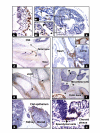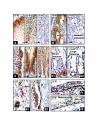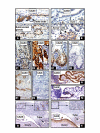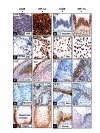Expression of transmembrane carbonic anhydrases, CAIX and CAXII, in human development
- PMID: 19291313
- PMCID: PMC2666674
- DOI: 10.1186/1471-213X-9-22
Expression of transmembrane carbonic anhydrases, CAIX and CAXII, in human development
Abstract
Background: Transmembrane CAIX and CAXII are members of the alpha carbonic anhydrase (CA) family. They play a crucial role in differentiation, proliferation, and pH regulation. Expression of CAIX and CAXII proteins in tumor tissues is primarily induced by hypoxia and this is particularly true for CAIX, which is regulated by the transcription factor, hypoxia inducible factor-1 (HIF-1). Their distributions in normal adult human tissues are restricted to highly specialized cells that are not always hypoxic. The human fetus exists in a relatively hypoxic environment. We examined expression of CAIX, CAXII and HIF-1alpha in the developing human fetus and postnatal tissues to determine whether expression of CAIX and CAXII is exclusively regulated by HIF-1.
Results: The co-localization of CAIX and HIF-1alpha was limited to certain cell types in embryonic and early fetal tissues. Those cells comprised the primitive mesenchyma or involved chondrogenesis and skin development. Transient CAIX expression was limited to immature tissues of mesodermal origin and the skin and ependymal cells. The only tissues that persistently expressed CAIX protein were coelomic epithelium (mesothelium) and its remnants, the epithelium of the stomach and biliary tree, glands and crypt cells of duodenum and small intestine, and the cells located at those sites previously identified as harboring adult stem cells in, for example, the skin and large intestine. In many instances co-localization of CAIX and HIF-1alpha was not evident. CAXII expression is restricted to cells involved in secretion and water absorption such as parietal cells of the stomach, acinar cells of the salivary glands and pancreas, epithelium of the large intestine, and renal tubules. Co-localization of CAXII with CAIX or HIF-1alpha was not observed.
Conclusion: The study has showed that: 1) HIF-1alpha and CAIX expression co- localized in many, but not all, of the embryonic and early fetal tissues; 2) There is no evidence of co-localization of CAIX and CAXII; 3) CAIX and CAXII expression is closely related to cell origin and secretory activity involving proton transport, respectively. The intriguing finding of rare CAIX-expressing cells in those sites corresponding to stem cell niches requires further investigation.
Figures








References
-
- Potter C, Harris AL. Hypoxia inducible carbonic anhydrase IX, a marker of tumour hypoxia, survival pathway and therapy target. Cell Cycle. 2004;3:164–167. - PubMed
-
- Tureci O, Sahin U, Vollmar E, Siemer S, Gottert E, Seitz G, Parkkila AK, Shah GN, Grubb JH, Pfreundschuh M, Sly WS. Human carbonic anhydrase XII: cDNA cloning, expression, and chromosomal localization of a carbonic anhydrase gene that is overexpressed in some renal cell cancers. Proc Natl Acad Sci USA. 1998;95:7608–7613. doi: 10.1073/pnas.95.13.7608. - DOI - PMC - PubMed

